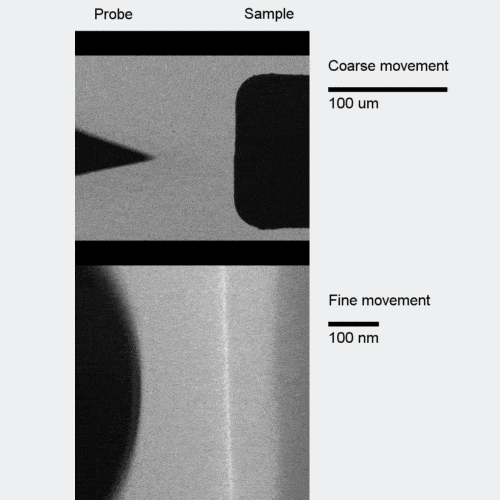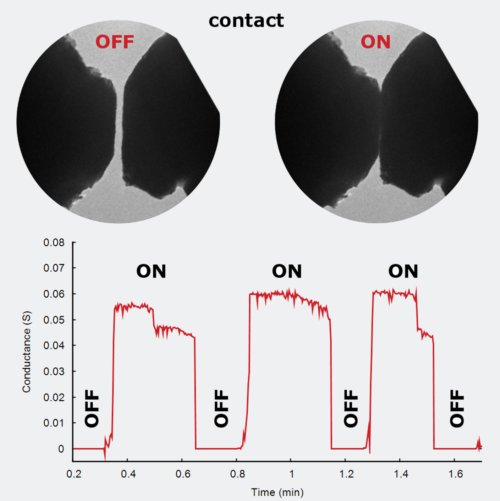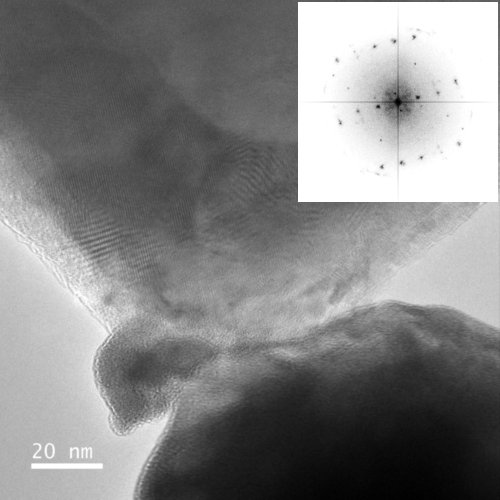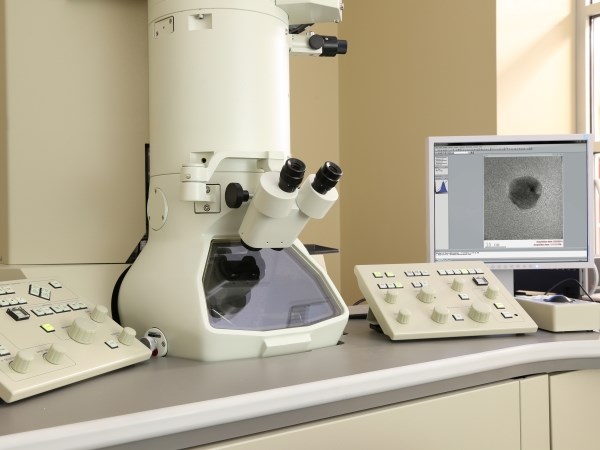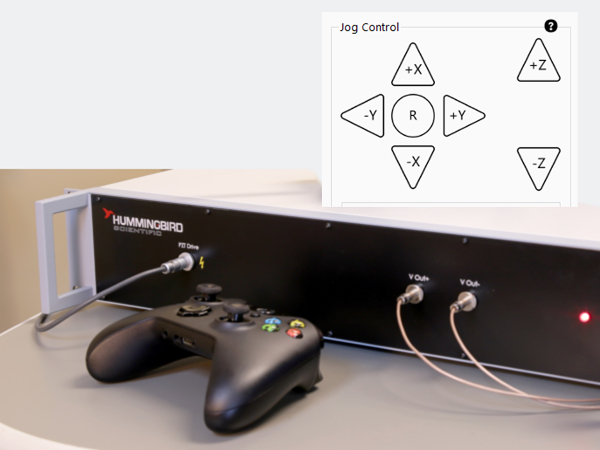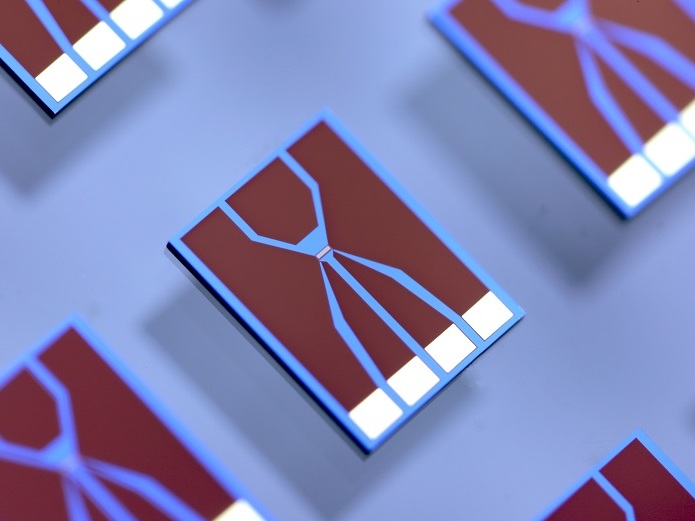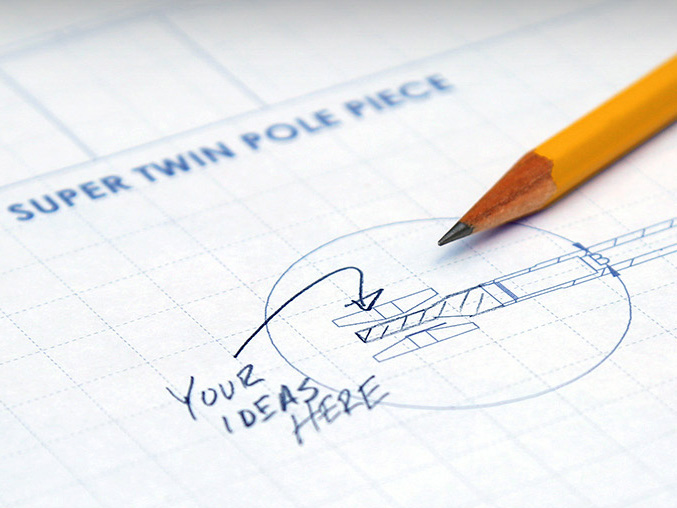

Biasing Manipulator

| 1800 Series | |
| Coarse Movement Range |
|
| X axis |
> 1000 µm |
| Y and Z axes |
500 – 1000 µm |
| Fine Movement Range | |
| X axis | 2 – 3 µm |
| Y and Z axes | ~ 40 µm |
| Electrical Contacts | 2 standard (3 – 7)* |
| Current Resolution | 100 pA standard (< 10 pA)* |
| Sample Compatibility | 3 mm half grids, FIB lift-out grids, or custom* |
| TEM Compatibility | TFS/FEI, JEOL, Hitachi |
*Contact us for optional availability and custom configurations
In-situ TEM probing of lithium interfaces for solid-state batteries
Using Hummingbird Scientific’s in-situ TEM Biasing Manipulator holder, researchers at Toyota Research Institute of North America and the University of Pennsylvania devised an experiment in which air-sensitive lithium metal is brought in contact with novel solid-state electrolytes to observe the degradation mechanism during the lithium charge and discharge cycles. They observed dendrites and delamination of lithium metal upon reaction with lithium thiophosphate (LPS) electrolyte. However, when the same electrolyte is doped with lithium iodide, the dopant plays a protective role and prevents such degradation. This improves the lithium cycling capacity. The in-situ TEM manipulation and biasing capabilities can accelerate the fundamental understanding and microstructural evolution of nanostructured battery materials to develop better batteries.
Figure: In-situ probing of solid LPS electrolyte against lithium metal showing lithium dendritic growth and delamination during charge and discharge cycle.
Image Copyright © 2020 American Chemical Society
Reference: Singh et al. Chem. Mater. 2020, 32, 17, 7150–7158. DOI: 10.1021/acs.chemmater.9b05286
Edit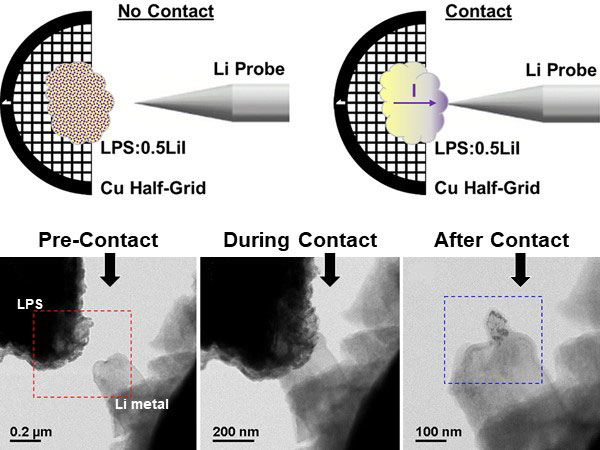
In-situ TEM of microstructural evolution in composite solid-state Li-ion batteries during charge/discharge cycles
Researchers at the University of Central Florida (UCF) have studied the structural integrity of a novel composite electrode composed of a polymer-derived ceramic nanoparticle and edge-functionalized graphene oxide during electrochemical lithiation and delithiation cycles.
They assembled a prototype nanobattery cell with a lithium metal and a SiCNO composite electrode and performed in-situ TEM lithation and delithation for at least two cycles using Hummingbird Scientific’s Biasing Manipulator TEM holder. The observed results demonstrated extraordinary structural stability of the SiCNO nanoparticles with only a 9.36% linear expansion during the lithiation (See Movie on the Left).
Movie Copyright © 2021 American Chemical Society
Reference: Zhang et al.; ACS Appl. Mater. Interfaces 2021, 13, 8, 9794–9803. https://doi.org/10.1021/acsami.0c19681
Edit| Ruikang Ding, Soodabeh Azadehranjbar, Ingrid M. Padilla Espinosa, Ashlie Martini, Tevis D. B. Jacobs. “Separating geometric and diffusive contributions to the surface nucleation of dislocations in nanoparticles,” ACS Nano (2024) | Abstract |
| Soodabeh Azadehranjbar, Ruikang Ding, Ingrid M. Padilla Espinosa, Ashlie Martini, and Tevis D. B. Jacobs. “Size-Dependent Role of Surfaces in the Deformation of Platinum Nanoparticles,” ACS Nano (2023) | Abstract |
| Ingrid M. Padilla Espinosa, Soodabeh Azadehranjbar, Ruikang Ding, Andrew J. Baker, Tevis D. B. Jacobs, and Ashlie Martini. “Platinum nanoparticle compression: Combining in situ TEM and atomistic modeling,” Appl. Phys. Lett. (2022) | Abstract |
| Fei-Hu Du, Ling Zhang, Yun-Cheng Tang, Shang-Qi Li, Yu Huang, Le Dong, Qianqian Li, Hong Liu, Dong Wang, and Yong Wang. “Low-Temperature Synthesis of Amorphous Silicon and Its Ball-in-Ball Hollow Nanospheres as High-Performance Anodes for Sodium-Ion Batteries,” Adv. Mater. Interfaces (2022) | Abstract |
| Supriya Koul, Yoshiyuki Morita, Fumika Fujisaki, Hiroshi Ogasa, Yoshiya Fujiwara, and Akihiro Kushima. “Effect of Liquid Metal Coating on Improved Cycle Performance of Anode-Free Lithium Metal Battery,” J. Electrochem. Soc. (2022) | Abstract |
| Andrew J. Baker, Sai Bharadwaj Vishnubhotla, Rimei Chen, Ashlie Martini, and Tevis D. B. Jacobs. “Origin of Pressure-Dependent Adhesion in Nanoscale Contacts,” Nano Letters (2022) | Abstract |
| Ingrid M. Padilla Espinosa, Soodabeh Azadehranjbar, Ruikang Ding, Andrew J. Baker, Tevis D. B. Jacobs, and Ashlie Martini. “Platinum nanoparticle compression: Combining in situ TEM and atomistic modeling,” Applied Physics Letters (2022) | Abstract |
| Supriya Koul, Le Zhou, Omar Ahmed, Yongho Sohn, Tengfei Jiang, and Akihiro Kushima. “In situ TEM Characterization of Microstructure Evolution and Mechanical Behavior of the 3D-Printed Inconel 718 Exposed to High Temperature,” Microscopy and Microanalysis (2021) | Abstract |
| Nikhilendra Singh, James Horwath, Timothy Arthur, Daan Hein Alsem, Marm Dixit, Pavel Shevchenko, Michael Jones, Kelsey Hatzell, and Eric Stach. “Using In-Situ TEM to Investigate the Role of Lithium Iodide Addition to Lithium Thiophosphate,” Microscopy and Microanalysis (2021) | Abstract |
| Frank Barrows, Hanu Arava, Chun Zhou, Paul Nealey, Tamar Segal-Peretz, Yuzi Liu, Saidur Bakaul, Charudatta Phatak, and Amanda Petford-Long. “Mesoscale Confinement Effects and Emergent Quantum Interference in Titania Antidot Thin Films,” ACS Nano (2021) | Abstract |
| Saisaban Fahad, Zhen Wei, and Akihiro Kushima. “In-situ TEM observation of fast and stable reaction of lithium polysulfide infiltrated carbon composite and its application as a lithium sulfur battery electrode for improved cycle lifetime,” J. Power Sources (2021) | Abstract |
| Zeyang Zhang, Jean E. Calderon, Saisaban Fahad, Licheng Ju, Dennis-Xavier Antony, Yang Yang, Akihiro Kushima, and Lei Zhai. “Polymer-Derived Ceramic Nanoparticle/Edge-Functionalized Graphene Oxide Composites for Lithium-Ion Storage,” ACS Applied Materials & Interfaces (2021) | Abstract |
| Marm B. Dixit, Nikhilendra Singh, James P. Horwath, Pavel D. Shevchenko, Michael Jones, Eric A. Stach, Timothy S. Arthur, and Kelsey B. Hatzell. “In Situ Investigation of Chemomechanical Effects in Thiophosphate Solid Electrolytes,” Matter (2020) | Abstract |
| Jung Ho Yoon, Jiaming Zhang, Peng Lin, Navnidhi Upadhyay, Peng Yan, Yuzi Liu, Qiangfei Xia, J. Joshua Yang, A Low‐Current and Analog Memristor with Ru as Mobile Species,” Advanced Materials (2020) | Abstract |
| Nikhilendra Singh, James P. Horwath, Patrick Bonnick, Koji Suto, Eric A. Stach, Tomoya Matsunaga, John Muldoon, and Timothy S. Arthur. Role of Lithium Iodide Addition to Lithium Thiophosphate: Implications beyond Conductivity. Chemistry of Materials (2020) | Abstract |
| Nikhilendra Singh, James Horwath, Timothy Arthur, Daan Hein Alsem, Eric Stach. “Using Operando Electrochemical TEM as Part of a Correlative Approach to Characterize Failure Modes in Solid-State Energy Storage Devices.” Microscopy & Microanalysis (2020) | Abstract |
| Eric Stach, James Horwath, Nikhilendra Singh, Timothy Arthur, Daan Hein Alsem, Norman Salmon. “Understanding the Relationship Between Air Exposure, Electron Dose and Beam Damage in Solid Electrolyte Materials.” Microscopy & Microanalysis (2020) | Abstract |
| Nikhilendra Singh, James Horwath, Alexandre Foucher, Timothy S. Arthur, Julio A. Rodriguez Manzo, Daan Hein Alsem, and Eric Stach. “Operando Electrichemical TEM of Solid-State Energy Storage Materials Using a Probe-Based Biasing Holder.” Microscopy & Microanalysis (2019) | Abstract |
| Julio A. Rodriguez Manzo, Daan Hein Alsem, Norman J. Salmon and David Cooper. “Good Contacts for Quantitative In-Situ TEM Biasing Experiments with Movable Probes.” Microscopy & Microanalysis (2018) | Abstract |
| Fei-Hu Du, Yizhou Ni, Ye Wang, Dong Wang, Qi Ge, Shuo Chen, and Hui Ying Yang. “Green Fabrication of Silkworm Cocoon-like Silicon-Based Composite for High-Performance Li-Ion Batteries,” ACS Nano (2017) | Abstract |
| Z. Yanga, J. Suna, Y. Nia, Z. Zhaob, J. Baob, S. Chen. “Facile synthesis and in situ transmission electron microscopy investigation of a highly stable Sb2Te3/C nanocomposite for sodium-ion batteries,” Energy Storage Materials (2017) | Abstract |
| Daan Hein Alsem, Siddharth Sood, Norman Salmon, and Tevis D B Jacobs. “In situ electrical testing of device-relevant nanocontacts in the transmission electron microscope,” Microscopy and Microanalysis (2016) | Abstract |
| C.M. Wang, W. Xu, J. Liu, D.W. Choi, B. Arey, L.V. Saraf, J.G. Zhang, Z.G. Zhang, S. Thevuthasan, D.R. Baer, and N. Salmon. ”In-situ transmission electron microscopy and spectroscopy studies of interfaces in Li ion batteries: Challenges and Opportunities,” Journal of Materials Research (2010) | Abstract |
| A.N. Chiaramonti, L.J. Thompson, W.F. Egelhoff, B.C. Kabius , A.K. Petford-Long. ”In-situ TEM studies of local transport and structure in nanoscale multilayer films,” Ultramicroscopy (2008) | Abstract |
Read More

